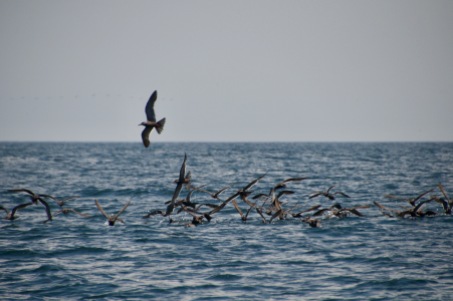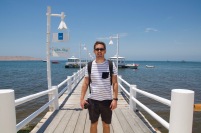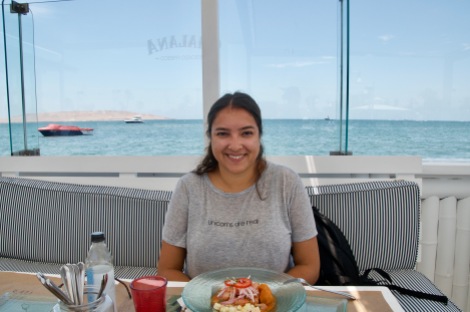Hello
We left Huacachina in the early evening and after a short hour and a half bus ride, we arrived in Paracas: a lovely, small, seaside town.
Paracas is the departing point to visit las Ilas Ballestas. They are a cluster of islands 20km from the shore that have an abundance of wildlife and so are nicknamed ‘The Poor Man’s Galapagos’. The Eastern South Pacific Ocean is one of the most rich, bio-diverse areas in the world. The tours last around two hours and we booked through Peru Hop for $15 (a lot cheaper than a cruise to the Galapagos). The islands are all protected, meaning you cannot walk on them or swim with the wildlife, so all viewing is done by boat. On the way to the islands, we passed another drawing in the rock similar to the Nazca lines with speculation ongoing regarding its origin. This one is called the Candelabra, stretching 150 metres. The key difference from the Nazca lines is that you don’t need altitude to see the drawing as it is visible from sea.
When we actually arrived at the islands, it was absolutely incredible. Never have I ever felt more like I was in an episode of Blue planet or in one of Sir David Attenborough’s documentaries. We saw more birds in that hour than in our entire lives combined! We managed to see a couple of Humbolt Penguins hidden within the thousands of other birds. We saw lots of Booby birds which actually migrate from the Galapagos islands; though they are not the iconic Blue-footed specie. We saw Peruvian pelicans which I must say, were my favourite! I don’t think I’ve ever seen massive pelicans like that; their beaks are so colourful and they are such majestic birds. We saw Inca Tern birds who perch along the steep rocky formations and also red-headed vultures. We saw loads of sea lions napping on the jagged rocks and red crabs loitering where the sea meets the rock. The most spectacular part was that one of the islands was literally covered with thousands and thousands of Cormorant birds. It was the most surreal sight, almost like the island was covered in a black carpet that was alive.
We joined in on the free tour offered by Peru Hop which takes you to the National Paracas Reserve. The local Quechua translation of the word ‘Paracas’ means Sandstorm, so as you can image, it was quite windy. We did three main stops on the tour, mostly just to admire the beautiful landscapes. The first stop was to see a Cathedral rock formation in the sea, though unfortunately, it was severely damaged by an earthquake causing the archway to collapse. So really, it was more just a stop to admire the Pacific Ocean. The second stop was to a view point where you could see the ocean on both sides of the reserve. Finally, we stopped at the red beach. The sand is sort of a rusted red colour and the contrast with the turquoise of the water is very striking. The colour is apparently due to fragments of rock brought by the waves from the Santa Maria headland which is made out of the igneous rock, Pink Granodiorite.
Our onwards bus to Lima was not until late in the afternoon so we just had a relaxing last day in Paracas, mostly revolving around food. We went for lunch on the outskirts of the little town where all the fancy five star hotels are. We had a little snoop of one of the hotels as the restaurant we were headed for was part of it. The restaurant, Chalana, was in the most beautiful setting, alone out on a pier! The restaurant only has a couple of food options because they only deal with the best, fresh catch of the day. We both had the ceviche which was pretty amazing. Ceviche is a really popular raw fish dish in South America though we have often been skeptical of trying it for fear of food poisoning with the raw element, but we figured we were safe at Chalana! After being so taken with the pelicans the day before, we spent our last afternoon pelican spotting. We saw a man with a sort of pet pelican (though he wasn’t trapped), the man was tossing food so that tourists could take photos with it. Though I really wanted a photograph of a pelican with it’s mouth open, I wasn’t going to let that be the photo I took. Fortunately, near the restaurant we found some sitting on the pier and though I didn’t get the mouth open shot, I did get some of them sleeping with turquoise waters and boats in the background that I was happy with.
We left Paracas around 5pm and headed for Lima, a 6 hour drive away. Peru Hop did a little detour to give a free tour of the former slave tunnels in Chincha on the way. It was a giant Manor House dating back to the 17th century, called Casa Hacienda San Jose, situated 17km’s from the coastline. Following first the taxation on slaves and then the abolition of slavery in Peru, the tunnels were created as a method to avoid tax and smuggle mostly African slaves into the estate to work on the farmland. There are storage rooms underneath the house where the slaves would often have to wait weeks, sometimes up to a month, in the pitch black with little air circulation before the doctor had assessed them for medical diseases.
We arrived around midnight in Lima and we stayed in the district of Miraflores situated on the coast. We only had two nights in Lima before our flight to Ecuador so we didn’t really venture outside of Miraflores, the main tourist district. We felt really safe walking around Miraflores and it reminded us quite a lot of Vila Madalena, where we stayed in Sao Paolo. We spent the day walking along the boardwalk towards El Parque del Amor (love park) which is situated on the cliff edge overlooking the sea. Paragliders jump off from there and though we watched for ages, the gliders couldn’t get the parachutes to stay up so they didn’t jump. We did see beautiful sunsets by the water though and we even found a statue of Paddington Bear (in darkest Peru)!
Thanks for reading and join us next time as we head to Guayaquil in Ecuador.
Sophie & Dave















































Gorgeous photos – what a place!
LikeLiked by 1 person
Thanks! Definitely. Have you been?
LikeLike
Nope but you’ve definitely encouraged me to go and visit! 😉
LikeLiked by 1 person